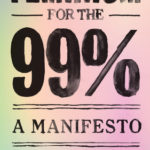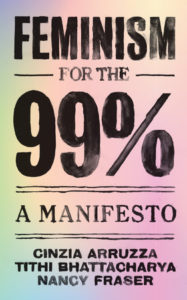Socialist Meaning in Feminist Mobilizations

 Feminism for the 99% calls attention to women’s mobilizations that are sweeping the world and argues for their revolutionary, anti-capitalist potential. At the same time, this compelling homage to the Communist Manifesto flips the focus from a classic notion of a proletariat (sometimes historically presumed to consist largely of working-class men) to a new configuration that includes women of all races and ethnicities around the world. Emphasizing the way levels of human dignity join with relations of production to shape the 99 percent, the authors attempt to explain how international capitalism is being challenged, and ultimately how it may be overthrown, by “a broad-based global insurgency.”1 Although some may scoff at the seeming presumption of such an argument, I find it breathtaking.
Feminism for the 99% calls attention to women’s mobilizations that are sweeping the world and argues for their revolutionary, anti-capitalist potential. At the same time, this compelling homage to the Communist Manifesto flips the focus from a classic notion of a proletariat (sometimes historically presumed to consist largely of working-class men) to a new configuration that includes women of all races and ethnicities around the world. Emphasizing the way levels of human dignity join with relations of production to shape the 99 percent, the authors attempt to explain how international capitalism is being challenged, and ultimately how it may be overthrown, by “a broad-based global insurgency.”1 Although some may scoff at the seeming presumption of such an argument, I find it breathtaking.
Arguing for the increasing centrality of working-class and peasant women and their allies to capitalist transformation, this book marks a major shift from many other Marxist critiques. In the authors’ desire to “overcome familiar, stale oppositions between ‘identity politics’ and ‘class politics,’” they argue that ongoing movements are beginning to constitute a worldwide configuration (56-57). Those of us who share a life-long commitment to social movements in the hopes that they could be brought together to bring about some form of democratic socialism will be happy to see this program once again brought to life. In fact, in at least one workshop on environmentalism as far back as the Hairu encampment of the 1995 Fourth United Nations World Conference of Women in Beijing, activists explored the possibility of confronting certain global polluters through coordinated action by suing them in some countries, striking against them in other countries, and mobilizing to shame them in still other places. Although the environmental workshop’s plan never emerged as a coordinated movement, the “Water War” in Cochabamba, Bolivia, from late 1999 to April 2000, united indigenous market women and truck farmers with local union activists and young people of both sexes to demonstrate against Bechtel’s privatization of SEMAPA, the regional water company. California activists provided additional support when they demonstrated in front of Bechtel’s corporate offices in San Francisco to publicize how the company’s Bolivian subsidiary even prohibited gathering rain water while it demanded a 200 percent return on investment to repair the water system. The government’s support of Bechtel’s subsidiary provoked armed struggle that ultimately drove Bechtel out. These and other instances of such mobilizations illustrate that many of what we sometimes used to call socialist feminists have long joined or even led local movements.
Feminism for the 99% rightly calls attention to the contemporary mobilizations of women that are increasingly developing around the world. Although the current wave of resistance may be said to have begun with the mobilizations and strikes following the 2008 financial crisis, according to this book, they first achieved recognition with the 2017 commemoration of International Women’s Day. Not to split hairs, it might be argued that mass strikes of this kind have a long history on the left dating back to the Socialist and anarchist launching of May Day in 1890, Woman’s Day in 1909, and International Women’s Day in 1910. This strategy of demonstrating the united force of workers and women has a long history on the left and gave rise to revolutionary action as far back as the “mass strikes” that Rosa Luxemburg considered in the book of that title.2 In a somewhat backhanded compliment, we might say that Feminism for the 99% recalls the spirit of her arguments, particularly her notion that it is “not the best organized workers … who will develop the greatest capacity for action, but the worst organized or totally unorganized.”3 Roughly summarizing, Luxemburg attempted to explain how somewhat “spontaneous” mass uprisings helped advance the cause of socialism to counter political parties’ tendency toward becoming bureaucracies. With contemporary social movements in mind, it might be argued that women’s, queer and gay rights activists’, and teachers’ mobilizations also offer critiques of capitalist values and, in the process, bring about activities for social reconstruction that they, their elected officials, and broad-based social movements can pursue.
Beginning in February 1917 in Petrograd, Russia, when poor and working-class women’s demands for bread and peace generated a revolution that neither the Bolsheviks nor Mensheviks thought wise to pursue, and contrary to V.I. Lenin’s later admonition to German Socialist Clara Zetkin that working women in Germany in the 1920s avoid talking about their personal problems and stick to discussions about working conditions, contemporary women’s movements have often made personal demands a part of their claims for social transformation. Although the celebration of May Day and International Women’s Day generally died out in the United States until the reinstitution of our International Women’s Day in 1969 or 1970, both lived on in one form or another elsewhere in the world.
Less a history of women’s social movements than an investigation of the possible turning point we may have reached between 2016 and 2018, Arruzza, Bhattacharya, and Fraser’s account refers to the massive October 2016 uprising against the banning of abortions in Poland and the far-reaching demonstrations in Argentina, Chile, Bolivia, Mexico, Uruguay, and Honduras against the vicious rape and murder of 16-year-old Argentine Lucía Pérez at the end of October 2016. The authors argue that the new movements challenge social and economic conditions ranging from provision of education to the availability of water and sanitation; to control over the forces of ethnic, racist, and sexual violence; to integrating migrants from across borders, and that the movements spread to Spain, Italy, Brazil, Turkey, Peru, Chile, Mexico, the United States, and dozens more countries (6).
It may be just a matter of taste, but the book, while confronting various theories of social change and critiques of capitalism, seems most compelling when it examines the complexities of building women’s alliances across class, race, and ethnicity, not just in the United States but around the world. The critiques of capitalism and the failures of feminist and other reform movements to act against the economic and social institutions that undergird capitalism couldn’t be more convincing. But the book is most useful for the questions it raises about the movements that aspire to create new forms of social justice and the difficulty of overcoming racial and ethnic differences that too often divide us.
Take for example the #MeToo movement. The white women who united against Harvey Weinberg and the other Hollywood, media, and business executives who molested and raped them have captured interest and found adherents almost everywhere. Yet according to Arruzza, Bhattacharya, and Fraser, “the first statement of solidarity with the women in show business came from immigrant farmworkers in California: They immediately recognized Harvey Weinstein not simply as a predator, but as a powerful boss, able to dictate who would be allowed to work in Hollywood and who would not (32-33).”
Others have emphasized the importance of social media, especially the accident of history that provided Alyssa Milano with the hashtag #MeToo. According to Time magazine’s extensive “Person of the Year 2017” report, someone familiar with the term “MeToo” shared it with Milano. She sent out a tweet asking those who had experienced such abuse to reply “#MeToo,” and, overnight, she received 30,000 responses. It was Tarana Burke and young Black, Brown, and indigenous teenagers whom she helped organize who first used the term “MeToo,” in 2006, to describe their abuse. Although the more elite white women who gained the attention of the media readily hoped to make alliances with poor women of color, a bad taste remains. As the 45-year-old activist Burke told an audience in Detroit in late 2018, “This is not about awareness. It’s about action.” She cautioned her audience to recognize that “with #MeToo being as big and loud as it is, we don’t need more awareness. This is about what happens after the hashtag, after the hoopla. This is about the work.”4
It is to the credit of Arruzza, Bhattacharya, and Fraser that they insist that “nothing that deserves the name of ‘women’s liberation’ can be achieved in a racist, imperialist society.”8 But, while identifying the cause as “capitalism,” they are ready to acknowledge the courage of ordinary women from Africa, Asia, Europe, Latin America, and North America who face the challenges of climate change, declining supplies of water, exploitation and sexual harassment on the job, lack of medical attention, and repression by the guardians of national borders. If the authors’ efforts to be comprehensive sometimes underestimate the importance of local, possibly reformist, struggles such as those waged around the availability and cost of clean drinking water in places as varied as Cape Town, Detroit, Philadelphia, or the Central Valley of California, their manifesto is not responsible for highlighting all the struggles for survival now taking place. This is not to dispute the ultimate value of revolutionary transformation, but to insist on the transitional need under capitalism to achieve immediate relief from life-threatening challenges.
If there is one complaint I would lodge it is that in distinguishing revolutionary anti-capitalism from ordinary reformist efforts, as any polemic is bound to do, this manifesto, if anything, underestimates the revolutionary achievements of “ordinary” feminists of all races and cultures all over the world. But its sterling achievement is to recognize how feminism, as a constantly regenerating movement, has succeeded in including women of all races and classes, in all social settings, in the long-term struggle for social transformation.
notes
- Cinzia Arruzza, Tithi Bhattacharya, and Nancy Fraser, Feminism for the 99%: A Manifesto (Verso, 2019), 57.
- Rosa Luxemburg, The Mass Strike, the Political Party and the Trade Union, 1906.
- Luxemburg, The Mass Strike, 51.
- Rochelle Riley, “#MeToo Founder Tarana Burke Blasts the Movement for Ignoring Poor Women,” Detroit Free Press, Nov. 15, 2016.